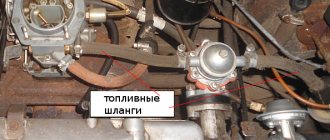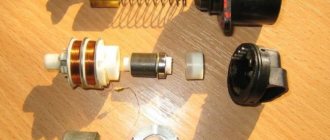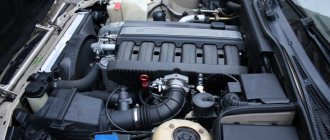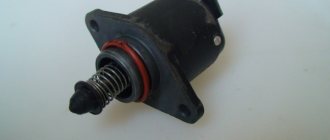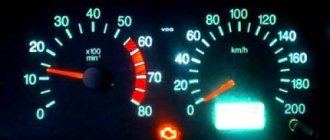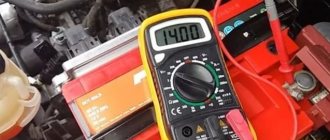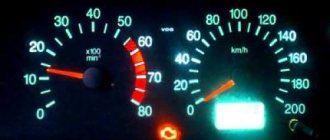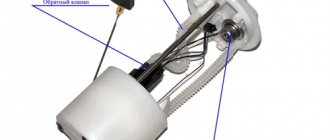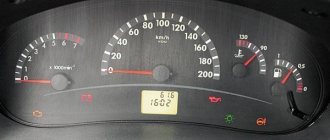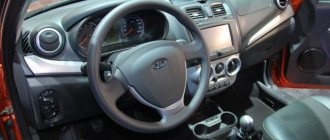Probably every car owner at least once in his life has encountered the problem of a stalling engine, and this can happen not only with domestically produced cars. So, some time ago, most drivers agreed that most often the engine stalled due to the technical features of the VAZ, however, as it turned out in practice, similar problems quite often occur on foreign cars. This means that it doesn’t matter at all whether your car is domestic or has a more “noble” origin - it is equally likely to stall at idle at the most inopportune moment.
The main reasons for engine stalling at idle
Before we begin to describe the main reasons why the engine stalls at idle, it is worth saying a few words about how this happens. You get into the car and start the engine, which functions as usual. But as soon as you take your foot off the gas pedal, a drop in revolutions is observed, although the idle speed sensor shows the nominal speed. At the same time, you can clearly hear that the engine is operating unstably, or even stalls completely. This is manifested by detonation of the propulsion system, which can cause very unpleasant complications.
It should be noted that when you start the engine again, the problem may not appear, and you can easily hit the road, but after a while the engine will stall again. That is why, after discovering the first malfunctions, you should immediately begin troubleshooting.
Almost every car owner has experienced engine stalling.
However, first of all, it is worth determining what exactly may be causing the incorrect operation of the power plant. As a rule, car owners and auto mechanics agree on the following main reasons why the engine may stall at idle:
- malfunction of the idle speed sensor or its complete failure;
- accumulation of dirt in the throttle valve;
- failure of the throttle position sensor;
- contamination of the carburetor or injector (depending on the type of car).
Of course, in some cases the problem may be more trivial: a misaligned battery terminal, an empty fuel tank, the use of low-quality fuel, etc. But we will not focus on them, since even an amateur car owner can solve these problems.
The causes of the malfunction in each individual case may differ radically, so you must be prepared to use various measures to eliminate them. As practice shows, experienced car owners are able to cope with the problem on their own, while beginners are better off immediately seeking the help of specialists.
Electrical problems
Often the reason that the engine refuses to idle is an incorrectly adjusted ignition angle. True, problems in this case are observed in all ranges of engine operation. All that is required to fix such problems is to set the ignition correctly and that’s it.
Spark plugs that are regularly filled with gasoline, or that have simply expired, can also cause the engine to stall at idle. In addition, you should check the ignition distributor, wiring and battery condition. Especially if the car is running rough, the engine is running rough, with jerks and dips.
Well, the starter will tell you in detail about the condition of the battery, especially on a cold engine. Most electrical problems can be diagnosed and fixed easily and without major investment.
Are there any differences in uneven operation on the carburetor and injector?
The reasons for silencing of carburetor and injection engines are somewhat different. So, for carburetor engines, the most common causes are:
- Failure of the carburetor itself due to debris. To fix the problem, you just need to rinse and clean the carburetor.
- A clogged fuel filter, as well as a clogged fuel pump filter mesh, which also need to be cleaned of spent fuel and other dirt.
- Failure of hoses and various rubber connectors - you just need to replace them.
- Failure of the solenoid valve can be resolved by replacing it. To identify the problem, you need to turn on the ignition, remove the wire from it, and after a few seconds connect it again, and you should hear a characteristic click. If there is no click and the warning lamp lights up on the instrument panel, the valve is faulty.
- A clogged idle jet can be solved by cleaning it.
- In some cases, the problem may be associated with incorrect operation of the idle speed sensors, the location of the throttle valve, and the crankshaft.
The idle speed control and the idle speed sensor are not the same thing. In some models they can be combined into one non-separable mechanism, in others - separately
For injection engines, the most common reasons for engine stalling and a drop in speed are:
- Malfunction of the idle speed control.
- Insufficient fuel pressure or air leaks - to eliminate the problem, you need to clean the filters and also make sure that the connecting elements are tight.
- Failure of the vehicle's electronic systems, for repair of which it is recommended to contact a specialized service center.
- Problems in the operation of the mass air flow sensor, as well as malfunctions in the ignition system - the main reason is related to the spark plugs.
How to fix the problem yourself
There is no universal instruction, since it all depends on the type of motor and the part that has failed or is not working correctly. But you can carry out some work that is not difficult and most often allows you to fix the problem:
- In a carburetor engine, first clean all the jets. To do this, they need to be removed and blown out. It is important to remember how many turns each element was screwed in. You can try to adjust the idle speed by tightening the corresponding jet. It is also important to check whether all components on the carburetor move; often they stick or move tightly; removal and cleaning or using a repair kit will solve the problem. At the same time, check whether the float is stuck or damaged.
- Be sure to check the intake system for air leaks. Inspect the rubber corrugation if present, pull the connections and tighten the clamps if necessary. Check for cracks in the rubber hoses.
- Remove the throttle body assembly and clean it if there is deposits on the inside walls. It is most convenient to use carburetor or brake cleaner. The spray quickly corrodes the plaque, and it is easily erased or even runs off.
- Cleaning the injectors yourself can be problematic, but you can use a special product that is added to the fuel. If the problem is minor, normal operation will be restored.
- Often the reason is broken high-voltage wires or worn-out spark plugs that do not produce a normal spark. It is best to simply replace these consumables to ensure the ignition system is working perfectly.
- It's worth checking the sensors. If they are inexpensive, it is easiest to replace them. On some models, these nodes can be cleaned to restore normal operation. It is also worth checking the flow meter, since the quality of the fuel mixture directly depends on it.
- The lambda probe is another element whose malfunction disrupts engine operation. You can find out that it is not working using computer diagnostics.
Important! If the above work does not bring results, it is better to contact specialists to conduct a more thorough check and identify why the machine is not working properly.
If your engine stalls or idles rough, it is important to identify the problem and fix it. Most often, this does not take much time and is inexpensive. The nature of the work may differ on different engines, so it is best to study the typical problems of your car so that you know what to check first.
Reasons for stopping a warm engine and a cold one
Experts note that the reasons for stopping the engine when cold and hot are in most cases no different and can be caused by the following malfunctions:
- vacuum leak;
- failure of the distributor cap, rotor, ignition wires or spark plugs;
- incorrectly set ignition timing;
- incorrect operation of the vehicle's ECU (electronic control unit) system, which can only be identified by using a special diagnostic device;
- malfunction of the exhaust gas recirculation valve;
- the presence of mechanical damage to the engine, as well as excessive wear of its elements;
- contamination of fuel injectors;
- malfunction of the idle air control (this problem often appears on Kalina cars).
The reason why the engine stops when cold can be a vacuum leak, dirty fuel injectors, etc.
About engine tripping
The term “troit engine” appeared in the Russian language when citizens began to use cars with a 4-cylinder engine. If any of the 4 cylinders stopped working properly, they said that the engine was failing. Now the same designation is used even for 6- and 12-cylinder internal combustion engine models, although this is not an entirely accurate designation of the malfunction.
The peculiarity of the problem is that it is detected only after the engine is started and the parts are significantly heated.
During warm-up, internal parts may change their characteristics and dimensions, causing damage to occur while driving. Since 1 cylinder is malfunctioning, driving even short distances becomes unforgettable: body vibration in the first 2 minutes will already prove that the car is not capable of moving. However, tripling may disappear and then reappear.
Why is idle speed unstable on diesel and gasoline?
In most cases, there is no difference whether a gasoline or diesel power unit is installed in your car - the reasons for the engine stopping will be identical. In this case, it is recommended to inspect and clean the throttle valves, and also check the functionality of the idle speed and throttle position sensors. If the problem is not resolved, then most likely you will have to completely replace the failed equipment, which can be identified by contacting specialists for help.
Moreover, it does not matter whether the engine stalls periodically or regularly - the very presence of the problem indicates a malfunction that must be eliminated as soon as possible.
Trouble-shooting
- If the reason why the car stalls at idle is low-quality fuel, then regardless of whether it is an injector or a carburetor, it is almost impossible to establish this fact. In such situations, experienced drivers simply drain the fuel. If after completely draining the fuel the problem does not disappear, then the reason is different.
- As for spark plugs, there is a certain scheme, following which you can achieve the desired result. It should be understood that there is one small difference in the spark plugs themselves, intended for a carburetor power plant and an injection one. This difference lies in the size of the gap between the contact of the spark plug and the electrode - for carburetor spark plugs it is larger, and for injection spark plugs it is smaller. But in practice, injection spark plugs are also suitable for a carburetor, and depending on the correct settings, the spark plugs can either work well or not work at all. The functionality of the spark plug is checked simply: with the engine running, at high speeds, you need to pull out the wire leading to the spark plug one by one. If the engine slows down, it means the spark plug is not working and needs to be replaced. If it is not possible to check using the above method, you will have to inspect each candle visually. The working spark plug must be dry. If the spark plug is black and wet, it means it is not working. In this case, you can replace the part, or you can simply “fry” it over the fire for about 10 minutes, and then carefully clean the contact and electrode with a stiff brush. You should clean it very carefully so as not to damage the electrode. Having removed the carbon deposits, the candle can be put back in place, and the problem should definitely disappear.
- Motor wiring faults can be easily checked. To do this, you need to drive the car into a dark place, start the engine, setting the speed so that it does not stall. Open the hood and inspect the wires leading to the spark plugs. If the wiring is damaged, the spark will be very visible in the dark. It is not recommended to insulate the wires and continue to operate the vehicle - this is very dangerous, as there is a high probability of the power plant catching fire. Only replacing damaged wires will solve the problem. And in this case it does not matter whether it is a carburetor or an injector.
- A clogged fuel filter is considered a fairly common problem leading to loss of idle speed, regardless of engine type. But it is the type of engine that determines the type of fuel filter. Carburetor engines have a transparent filter, and the fuel level in it is visible visually. You can also visually inspect how clogged it is. In injection systems, the fuel filter is electronically controlled, and it is impossible to visually inspect it. Sometimes, upon inspection, it is difficult to determine whether the filter has lost capacity. In this case, it is best to replace the part. If the problem does not go away, then the cause is something else. In new cars, if the filter is faulty, the Check indicator will indicate. Diagnostics can be performed by connecting a computer. The program will automatically detect the failure. If this is not possible, you can try replacing the part and evaluate the result.
- The air filter plays an important role in both carburetor and injection engines. And if the engine stalls at idle, it is recommended to replace it. The part is inexpensive, and even if it is not the cause, replacing it will not harm; on the contrary, it will help extend the life of the engine.
- Often idle speed is lost due to dust getting into the idle jet. This problem is present only in carburetor engines. To correct the situation, you need to unscrew the part and clean it under air pressure. The jet itself is located in the middle part of the carburetor on the condenser. If you can’t clean it with air, you can do it with a very thin wire. The procedure is simple and takes no more than 10 minutes.
- If the engine does not idle due to a faulty fuel pump, then it is best to replace it. To make sure that the “diagnosis” is correct, you need to pull out the pipe leading to the carburetor from the pump and first try to pump the fuel manually, and then using the starter. If fuel does not flow out of the pipe, it means the fuel pump is faulty. If we are talking about a plunger pump, then you can change the membrane in it. But such repairs will not last long. As for the injection fuel pump, everything is much more complicated. The part is located in a special flask, which is located in the car tank. To remove the fuel pump, you must first drain the fuel and remove the bulb. Typically, an injection fuel pump cannot be repaired, and even if repair work is carried out, it will not have a lasting effect. Experts recommend replacement.
- A poorly set ignition always affects engine performance. And very often this fact becomes the reason for the lack of idle speed of the power unit. For carburetor engines, you can set the ignition using a distributor. To do this, you need to start the engine and turn the distributor. This must be done slowly, since even a millimeter will affect the operation of the installation. Having found the desired position, the distributor is fixed using a fastener. It must be fixed securely, as the problem may recur.
- If the reason for the disappearance of engine idle speed is the “suction” of air, then first of all it is necessary to inspect the carburetor body, and then its gasket. The presence of any, even the most insignificant, flaw will indicate the correctness of the search. If we are talking about a crack in the body of a part, then it is best to replace it immediately. The carburetor itself is not cheap, but repairs are simply inappropriate here - the result will only be temporary. As for the gasket, it is cheap, and replacing it will not be difficult or particularly expensive. You just need to remove the air filter and the top of the carburetor, replace the gasket and put everything back together.
Diagnostic sequence
No specialist can give any precise recommendations on the diagnostic sequence, but if the problem of a suddenly stalling engine appears periodically, you can wait a little and try to determine under what circumstances it occurs. It would also be a good idea to visit specialized forums dedicated to the problems of a particular make and model of car.
To carry out the most accurate diagnostics, it is recommended to connect the car to a special diagnostic device, which can be found at any specialized service station.
Dirty throttle valve and pipes
From time to time the throttle valve becomes clogged, for example if the air filter is already in poor condition. Then it’s worth removing all the pipes from the throttle, checking them for permeability and blowing them out. It definitely won't be redundant.
Next, disconnect the throttle cable and wires and remove the throttle. The cleaner can be found at any auto store. In case of heavy contamination, take a clean container and soak the throttle valve in gasoline in it for some time. Don't be afraid to blow out absolutely everything, as the throttle has narrow channels that can also clog.
How to check the wiring?
There is one, rather risky way to find the cylinder: disconnect the high-voltage cables from the running engine one by one. By disconnecting the power from the ignition, it will be possible to understand which of the cylinders is not working, thereby significantly narrowing the search.
However, there is a risk of electric shock. It is not fatal, but it is quite painful, so you need to take care of your protection. You can start working if you first put on rubber gloves and stand on a rubber mat. Then follow these tips:
- Turn on the engine, raise and secure the hood.
- One by one, you need to disconnect the cables from the spark plugs. You must hold on to the insulation, not the tip of the wiring; you must not touch the body while removing the live wiring.
- If you turn off the slave cylinder, you will hear that the sound of the engine running has changed. But if it is faulty, then nothing will happen.
Cars with gasoline engines
A gasoline engine may not start after warming up quite often, especially when operating in low temperatures. The fact is that the fuel remaining in the chamber begins to evaporate quickly due to elevated temperatures. Vapors fill all cavities, including the carburetor, manifold, and air filter. As a result, fuel levels in the float chamber decrease and gas plugs occur. The duration of this process depends on the design of the fuel system and on the external temperature conditions.
That is, the reason why a gasoline engine does not warm up after warming up lies in excessive evaporation of gasoline and the formation of an enriched fuel mixture.
